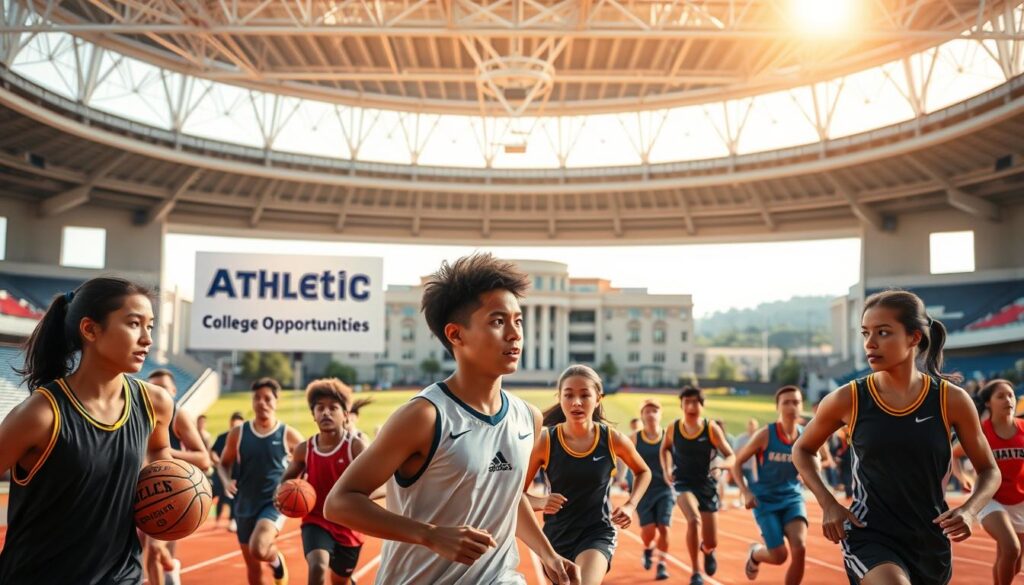Securing an Athletic Scholarship for College: What You Need to Know
Did you know only about 2% of high school athletes win college sports scholarships? This fact shows how tough the competition is. It stresses why student-athletes must learn the ins and outs of this process. These scholarships help with school costs and let athletes pursue their sports dreams and education together.
In this guide, we explain what athletic scholarships are, the different kinds available, and what you need to qualify. Understanding these basics helps us get ready for what lies ahead.
Key Takeaways
- Understanding the competitive nature of athletic scholarships for college.
- The variety of collegiate athletic scholarships available.
- Importance of meeting eligibility criteria for funding.
- Blending sports and academics increases chances of success.
- Scholarships provide essential financial support for education.
Understanding Athletic Scholarships
Athletic scholarships are key for students who excel in sports and seek higher education. They reward athletic talent, asking for a commitment to the school’s team. Knowing about these scholarships helps us understand the world of college sports better.
What Are Athletic Scholarships?
Athletic scholarships are also known as NCAA scholarships. They help cover school costs like tuition and boarding for student-athletes. This allows them to focus on school and sports. Being an athlete in college opens many doors for their future.
Types of Athletic Scholarships
There are mainly two kinds of athletic scholarships: Headcount and Equivalency sports. Sports like football and basketball offer full-rides to athletes. This means the school covers all their education costs.
Equivalency sports, such as track and field, give partial scholarships. Coaches can spread the funds across several athletes. Understanding the difference helps in making choices about college recruitment.
Eligibility Criteria
To get an athletic scholarship, athletes must meet certain criteria. They need to follow NCAA rules, keep up their grades, and score well on tests like the ACT or SAT. Using athletic recruiting services helps understand these requirements better.
Benefits of Athletic Scholarships
Getting an athletic scholarship can change a student’s life. It offers financial support, leads to academic opportunities, and opens up networking possibilities. These benefits help students during college and in their future.
Financial Support
A big benefit of athletic scholarships is the financial help they give. They can cover many college costs like tuition and books. By getting sports scholarships, we can focus more on school and sports, not money. Scholarships can also add up with other college grants, giving us more money to use.
Academic Opportunities
Athletic scholarships also help with school, not just sports. They often offer tutoring and help us do well in both school and sports. This means we get a great college experience and prepare for future jobs.
Networking Possibilities
College sports help us meet many new people. We get to know coaches, athletes, and former students. These connections can lead to jobs and internships later. The friends and contacts we make now help us long after college.
How to Find Athletic Scholarships
Finding athletic scholarships takes hard work and detailed research. We can start by looking through many available places to find funding help. There are many resources, like college sports programs and scholarship databases, to help student-athletes. Talking to both local and national groups can also give us good tips for applying.
College Athletic Programs
Many colleges have athletic scholarships in their sports departments. Looking into colleges with strong sports programs is smart. They often have staff ready to show us what scholarships they offer.
Scholarship Databases
Now, there are lots of databases with scholarships for student-athletes. Sites like Fastweb and Cappex let us find scholarships that fit our sport and skill level. It’s important to use these tools to make our scholarship hunt easier.
Local and National Organizations
Many local and national groups have scholarships just for student-athletes. Groups like the NCAA and the NAIA show scholarships and resources on their websites. Finding these organizations can help us discover specific scholarships for athletes.
| Resource Type | Examples | Focus Area |
|---|---|---|
| College Athletic Programs | University of Florida, Stanford University | Direct scholarship offerings |
| Scholarship Databases | Fastweb, Cappex | Comprehensive scholarship listings |
| Local & National Organizations | NCAA, NAIA | Sport-specific opportunities |
Preparing for Scholarship Applications
To get athletic scholarships, preparing well for the application process is key. We need every part of our application to show how hardworking and skilled we are. It should highlight our sports skills and our academic strengths.
Building an Athletic Resume
Creating a strong athletic resume is our chance to make a good first impression. It’s important to list our achievements, best performances, and important experiences.
This resume should give a full picture of our abilities. It needs to include our best stats, awards, and big moments. Using athletic recruiting services can help us figure out what coaches want to see.
This way, we can make our resumes more appealing to coaches and scholarship groups.
Crafting a Compelling Personal Statement
The personal statement is a big deal in scholarship applications. It’s our chance to share our dreams, dedication to sports, and study goals. A well-told story can truly show who we are.
Telling stories about our challenges or achievements can highlight our passion and drive.
Gathering Recommendation Letters
Strong recommendation letters are very important. They come from coaches, mentors, and teachers who know us well. They should speak to both our sports and school achievements.
It’s crucial to pick people who can share how dedicated we are. These letters add a lot to our application. They show more about who we are and how we work.
The Recruitment Process
The process of getting an athletic scholarship involves many steps. It’s controlled by rules from the NCAA and NAIA. If we learn these rules, we have a better shot at getting scholarships for college sports. It’s key to tackle this process eagerly to boost our chances.
Understanding NCAA and NAIA Regulations
The NCAA and NAIA have their own set of rules for scholarships. Knowing these helps us avoid mistakes and grab every opportunity. They tell us when we can talk to coaches and what we need to do to get scholarships. Getting to know these rules is crucial for planning our recruitment journey.
Communicating with Coaches
Talking well with college coaches is essential. Being upfront shows our enthusiasm and keeps us on their radar. It also lets us share what we aim to achieve and lets coaches see if we fit their team. When we write emails or shoot videos, it’s important to talk about what we’ve done and our goals.
Campus Visits and Tryouts
Going to campus visits and tryouts is a big deal. It lets us show off our skills and attitude up close. Meeting coaches and team members face-to-face can help form lasting bonds, which might lead to scholarships. Also, seeing the campus firsthand lets us see if the school is right for us.
| Aspect | NCAA | NAIA |
|---|---|---|
| Eligibility Requirements | Core courses and GPA minimum | High school diploma and enrollment requirement |
| Communication Period | Defined recruiting period | Less restrictive communication rules |
| Scholarship Limits | Full and partial scholarships available | Full and partial scholarships available |
Showcasing Your Talent
To get noticed by college coaches, it’s important to show off our sports skills. Highlight videos are a great way to do this. They let us display our best moments and achievements. By picking our top highlights, we can grab the attention of schools looking to give out sports scholarships.
Importance of Highlight Videos
Making a good highlight video is key for scholarship applications. It shows our top plays in a short video. When making highlight videos, we should focus on:
- Key skills and moves
- Top moments from big games
- Our overall sports ability and flexibility
It’s important to create a video that’s both interesting and shows our sports promise. Aim for a 3-5 minute video and include how to contact you at the end.
Attending Showcases and Tournaments
Going to showcases and tournaments lets us perform for college scouts. It’s a chance to show our skills in real games. We should look for:
- Known events for our sport
- Places where many college coaches go
- Local, state, and national events
Joining these events can really help us get noticed and earn sports scholarships.
Maintaining Performance in High School
Doing well in high school sports is vital for scholarship opportunities. Coaches look for talent, hard work, and dedication. To stand out, we must:
- Keep playing well
- Show good sportsmanship and teamwork
- Do well in school alongside sports
Being strong in both sports and academics makes us strong candidates for college teams.

Academic Requirements
To get sports scholarships, good grades are key. Keeping a high GPA and scoring well on tests like the SAT or ACT helps a lot. Good time management is needed to balance sports and studying. We’ll look at what you need for these scholarships.
GPA and Test Score Expectations
The NCAA has set rules for grades and test scores. A high GPA shows hard work and helps get scholarships. Depending on the sports division, you might need a GPA between 2.3 and 3.0. Good SAT or ACT scores are also important, so start preparing early.
Balancing Sports and Academics
It’s tough to keep up with sports and school. Use time management to do well in both. Plan your study time and get help like tutoring if you need it. Aim to do your best in class and your sport.
Importance of a Strong Transcript
A good transcript shows you’re serious about school. When you apply for scholarships, colleges really look at your grades. They like seeing improvement and tough classes. Taking advanced classes shows you care about learning and your sport.
| Criteria | Division I | Division II |
|---|---|---|
| Minimum GPA | 2.3 | 2.2 |
| Minimum SAT Score | 900 | 820 |
| Minimum ACT Score | 75 | 68 |
Financial Considerations
It’s important to know about the money side of athletic scholarships. They help make college more affordable. Athletes often use these scholarships to pay for school. We will look at how they can lower costs and other ways to get money for college.
Tuition Costs and Scholarships
The cost of college varies a lot. Athletic scholarships can ease this burden, especially in Divisions 1 and 2. In some sports, scholarships are shared, leading to less cost for individual players.
Understanding the True Cost of Attendance
We need to think about the full cost of college, not just tuition. This includes living costs, books, and other fees. These extra costs should be in our financial plans. Not all scholarships cover these, so planning is key. Check out resources for a full cost breakdown of college.
Resources for Additional Funding
Besides scholarships, there are other ways to get money for college. We can look into grants, loans, and work-study programs. Don’t forget about university athletic grants—they’re a big help. Federal aid is also an option. To learn more about getting extra funds, visit this resource.
Common Misconceptions
Many students who dream of securing athletic scholarships believe in common myths. These myths can stop them from chasing their athletic dreams in college. It’s crucial to know the truth behind these misconceptions to pursue college support through sports.
Scholarships Are Only for Stars
A big myth is that only the best athletes get scholarships. While it’s true that stars often get noticed, there’s more to the story. Schools also grant scholarships to athletes who have potential and are willing to work hard. Coaches value dedication and the desire to get better, not just winning records.
You Can’t Be Recruited Without a Local Coach
Some think you need a local coach to get noticed by colleges. But that’s not always the case. Athletes can connect with college coaches from anywhere, thanks to technology and sports events. Showing your skills and reaching out can open doors to college programs.
Athletic Scholarships Replace Academic Aid
There’s a misunderstanding that getting an athletic scholarship means you don’t need academic aid. Actually, athletic scholarships can go along with academic ones. They both work together to help cover college costs. This creates a fuller support system for students.

| Misconception | Reality |
|---|---|
| Scholarships are only for elite athletes | Many opportunities exist for athletes showing potential. |
| Local coaches are essential for recruitment | Relationships can be built from any location. |
| Athletic scholarships replace academic aid | They can complement academic scholarships and other financial aid. |
Acceptance and Terms of Scholarships
When we think about accepting an athletic scholarship, it’s important to be careful and understand everything. We need to know fully what the scholarship offer says and the promises we make by joining a program. Being smart about applying for a scholarship can really change our future in sports.
Understanding Your Offer
If we get an offer from the NCAA, it’s crucial to look closely at every part of it. This means checking how much of school fees it covers, any extra costs, and how long the scholarship lasts. Understanding this prepares us for the journey ahead.
Commitment to a Program
Saying yes to a scholarship means we promise to do our best in the athletic program. Coaches count on us to perform well and show good sportsmanship. Keeping up our grades is also key. If we don’t, we could lose our scholarship.
Renewal and Eligibility Conditions
It’s also key to understand how to keep our scholarship. Most times, we have to meet certain standards, like keeping up a certain GPA and finishing enough classes. Getting to know these rules helps us stay qualified during our time in college.
| Scholarship Component | Description |
|---|---|
| Financial Coverage | Includes tuition, fees, and sometimes room and board costs. |
| Duration | Specifies the number of years the scholarship will be awarded. |
| Performance Expectations | Outlines athletic goals and standards we must meet. |
| Academic Standards | Details on GPA and credit hours required for renewal. |
| Renewal Conditions | Criteria that must be met each year to maintain the scholarship. |
Tips for Success
To get a college sports scholarship, we need more than just talent. We must focus on our goals, connect well with coaches, and keep getting better at our sport. Each step is key to get and keep a sports scholarship.
Staying Focused on Your Goals
We should set clear athletic and academic goals. Checking these goals regularly helps us stay on path and make needed changes. It’s important to do well in both sports and school, as grades can affect our scholarship chances.
Building Relationships with Coaches
Getting to know coaches can really help us win a sports scholarship. A good relationship with a coach shows our dedication. Keeping in touch and working hard in practice can increase our chances of getting an offer.
Continual Improvement and Training
It’s crucial to never stop improving in our sport. Hard training and listening to feedback makes us better athletes. By getting better and showing our improvements, we become more likely to earn a scholarship. Checking out resources like tips on applying for athletic scholarships can give us an edge.
Next Steps After Securing a Scholarship
So, you’ve gotten an athletic scholarship for college. Now, it’s time to get ready for college sports life. The challenge here is to keep up in both sports and studies. Being an athlete in college means you also have to do well in class.
Transitioning to College Athletics
Getting into college sports means tougher training, more practice, and competitions. It’s key to talk openly with our coaches for advice on handling these new duties. We need to get to know our team’s culture, learn what they stand for, and what they expect from us. Taking these steps shows we’re serious about our sport and schooling.
Balancing Athletics and Academics
Balancing sports with school is key to doing well in college. Being good at time management helps us find time for training, studying, and resting. Also, using campus help like academic advisors and tutoring centers is smart. They assist us in staying on top of our studies and sports.
Resources for New Athletes
Starting our college athlete journey, we should use all available resources. Many colleges offer workshops on how to succeed in school and mental health support just for athletes. Taking part in these programs can make our college experience better. It helps us grow as athletes and individuals as we tackle college life.









